Many came for the first anniversary of Save the Great South Bay at Patchogue’s Blue Point Brewery on Saturday, August 18th. That afternoon everyone got together to celebrate the same cause. Pollution has become so bad in the bay that the once lucrative shellfishing industry has come to a halt. Long Island's waters were once responsible for more than eighty-three percent of New York State’s hard clam production 40 years ago and now that number has dwindled down to zero.
Both the bar and the backyard of the Brewery were packed with people celebrating and partaking in the festivities at the Save the Great South Bay event. Frisbees were thrown around, music was played, and stands sold beads and t-shirts that had Jim Morrison and Hunter S. Thompson on them. On tap was a variety of locally brewed beer. The beer strayed from the typical tasting Millers and Budweisers, and the Brewery instead offered more unique flavors such as pumpkin and blueberry. They even offered up to three free samples for first-timers, making it easier to pick out a great, locally brewed beer.
The crowd was passionate, and the warm weather made it a good day for activism. At around 3 o’clock Marshall Brown, founding member of Save the Great South Bay, hit the stage in the Brewery's backyard to speak about our polluted waters. “Its been horrific what happened,” he said. “The good news is we know why this is happening and we know how to fix it. The science is all there.” Brown received help from various research institutions and non-profit groups to find out the root of the bay’s pollution problem.
“The problem is we have 500,000 septic tanks in Nassau and Suffolk that’s contributing to waste and water pollution in our bays,” Brown explained. “If we want to have a future on Long Island we need to deal with that first.”
Christopher Clap from the Nature Conservancy spoke after Brown. “We’d been doing shellfish restoration work here in Great South Bay for almost ten years now and when we started ten years ago we knew there was a big problem here,” Clap said. “We know now there’s too much nitrogen in our groundwater. That nitrogen got in our groundwater through our development patterns here on Long Island.” Clap said developers used Roman technology to build this modern civilization we live in today.
Clap explained that Long Island developers installed septic tanks over sewage systems because they didn’t want Suffolk to look like Nassau or Queens. Their decision to go down the route of the leaky septic systems led to an increase of nitrogen in our groundwater by 200% in the last twenty years.
“There’s technology in place that we can implement right now if there’s the political will and the will of some bureaucrats of Suffolk County to do so,” Clap said. “I urge you all to keep on top of Marshall’s website and look for actions items of who to write to.”
Clap said one of the biggest improvements for the bay was a new inlet which helped clean up pollution levels. “We know that that inlet is causing great fluke fishing in Bellport bay and clams with big growth rings. Things we haven’t seen in years.”
Save The Great South Bay was formed last August at a 35th Sayville High School Reunion, where the attendees shared their shock and dismay at what the bay had become. They determined that The Great South Bay had to be revitalized so that our children and grandchildren could swim, boat, clam and fish there. Save the Great South Bay has over 500 members since Jan 1st and has enlisted a number of local baymen and marine scientists studying the bay to the cause. It promotes new technologies, green practices and policies for healing the bay, our ponds, rivers and streams. It is a place where all those who love The Great South Bay and The South Shore can gather together to build a healthy, sustainable bay. To learn more, visit their website, "Like" the Facebook Page, join their Facebook Group, or follow Save the Great South Bay on Twitter.
[Source: Save The Great South Bay]










